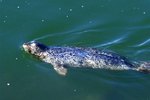Despite their name, fat sand rats (Psammomys obesus) aren't actually rats at all, but rather belong to the gerbil family. They tend to measure between 5 and 7 inches long and weigh between 4 and 7 ounces, with females slightly heavier than males. These rodents can be found in North Africa, from Mauritania to Egypt, usually residing in sandy deserts.
Cryptic Coloration
Fat sand rats have cryptic coloration, which means their coats are specially adapted to help camouflage them in their habitat. Depending on the area in which they live, their dorsal fur can vary between red, yellow and light brown, with black speckles. The fur on their undersides is lighter in color. This coloration allows them to blend in with the desert environment in which they live and helps them to avoid being spotted by predators.
Water Worries
It can be hard to find enough to drink when you live in arid areas, but fat sand rats are able to get all the fluid they need by eating leaves from saltbushes, plants with a 90 percent water content. The problem with saltbushes is that, true to their name, they contain high levels of salt. However, fat sand rats' kidneys are very efficient and can produce highly concentrated urine to expel excess salt from their bodies.
Dig This!
A range of predators -- such as snakes, owls and jackals -- will make a meal of fat sand rats in their native environment. However, they're able to avoid them for the most part by seeking protection in their burrows. These rodents dig their burrows with the help of their heavy feet and their large claws that can measure nearly a quarter of an inch long. Their burrows also help them survive the harsh desert climate, offering them shelter from both extreme high and low temperatures.
What's in a Name?
Fat sand rats are so called because they can, at times, be rather fat. When there's plenty of food around, these rodents cram in as much as possible to create fat reserves. They're able to store this fat in thick layers all over their bodies. When food is scarce, they get their energy by burning off their excess fat. Thus they can survive through harsh times when other animals might starve.





